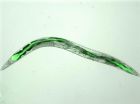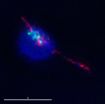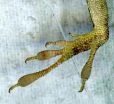(Press-News.org) LA JOLLA, CA – October 23, 2014 - Breaking carbon-hydrogen (C-H) bonds to alter existing molecules to create new ones is an increasingly important avenue for drug development. Of particular interest is mirror-image or "one-handed" compounds, but C-H breaking methods for making pure batches of these molecules have worked with only a limited range of starting materials.
Now a team from The Scripps Research Institute (TSRI) has established a new C-H activation technique that opens the door to creating a broader range of pure molecules of one-handedness or "chirality" by eliminating previous starting material limitations.
"This opens a new avenue to create chirally pure molecules for drug discovery," said Jin-Quan Yu, who is Frank and Bertha Hupp Professor of Chemistry at TSRI. "The potential may be huge."
In the new study, which was published in the October 24, 2014 issue of the journal Science, the scientists worked with chiral amines, a class of chemical compounds that include some of the most potent and successful pharmaceuticals, including the antidepressant Zoloft and codeine. However, the same methods should also apply to other chemical classes.
The reactions involved all occur at room temperature with cheap, readily available constituents—all attractive features when looking ahead to the possibility of manufacturing new pharmaceuticals based on the technique.
Manipulating Mirror Images
The new research centers on the synthesis of chiral molecules, which are mirror images of each other called enantiomers that often possess different biological activities.
One example of this is thalidomide. Thalidomide, which was given to pregnant women as a sedative and anti-nausea drug in the 1950s in Europe, turned out to produce debilitating birth defects such as missing limbs. But, in fact, only one enantiomer of the molecule is responsible for these effects. Enantiomers are typically produced at similar rates, making mixtures that can be difficult to separate.
In recent years Yu's group has published vastly improved methods for breaking C-H bonds, also known as C-H activation. The resulting removal of a hydrogen atom creates an ideal reactive site for adding new functional pieces to a molecule. However, Yu was not satisfied with the ability of these methods to create chirally pure molecules.
In C-H activation reactions, much recent work to create chirally pure batches of molecules has relied on a process called "desymmetrization." However, a limitation of this process has been that the starting material needs to have two symmetric C-H bonds attached to two identical aryls or alkyls, called prochiral C-H bonds.
Breaking Good
The new method uses the metal palladium, combined with an amino acid, as a catalyst capable of breaking C-H bonds. The trick is the ability of the amino acid ligand bound to the palladium catalyst to select which mirror-image enantiomer of the starting material to react. Once the palladium breaks the C-H bonds of the desired chiral molecules to create a new open spot, iodine will bond to replace the removed hydrogen.
"That iodine is the magic, it can be replaced with anything as medicinal chemists wish," says Yu, "That's the beauty."
In developing the method, Yu and his team took lessons from past work and tested a variety of catalysts until they identified a benzoyl-protected L-leucine as a ligand that guides the palladium catalyst to react preferentially with only one of the two mirror-image enantiomers in the starting amine mixture. This produces a mixture where almost all of one enantiomer is iodinated, while the other remains unchanged, and iodinated molecules are easily separated from others. This type of preferential production of one enantiomer over another is known as kinetic resolution.
The team has already created a variety of chiral amines using the new technique to demonstrate its potential, and the researchers are planning to apply variations on their technique to other classes of compounds.
The group's focus is on basic chemistry, but Yu says it will be relatively simple for other chemists to further modify such new molecules and countless more to test for pharmaceutical potential.
"Someone could develop this further and do amazing things," said Yu.
INFORMATION:
In addition to Yu, other authors of this study, "Room-temperature enantioselective C-H iodination via kinetic resolution," were first author TSRI graduate student Ling Chu and TSRI Research Associate Kai-Jiong Xiao.
Support for this study came from TSRI and the National Institutes of Health (2R01GM084019).
About The Scripps Research Institute
The Scripps Research Institute (TSRI) is one of the world's largest independent, not-for-profit organizations focusing on research in the biomedical sciences. TSRI is internationally recognized for its contributions to science and health, including its role in laying the foundation for new treatments for cancer, rheumatoid arthritis, hemophilia, and other diseases. An institution that evolved from the Scripps Metabolic Clinic founded by philanthropist Ellen Browning Scripps in 1924, the institute now employs about 3,000 people on its campuses in La Jolla, CA, and Jupiter, FL, where its renowned scientists—including two Nobel laureates—work toward their next discoveries. The institute's graduate program, which awards PhD degrees in biology and chemistry, ranks among the top ten of its kind in the nation. For more information, see www.scripps.edu.
DURHAM, N.C. -- When pathogenic bacteria like Salmonella or Staphylococcus invade a host, the host organism should respond by going into a state of high alert, altering its metabolism to defend against the attack.
But if the host doesn't reverse course once the battle is won, its efforts will be wasted on defense rather than on repairing the damage done by bacterial invaders.
Duke University researchers have uncovered the genes that are normally activated during recovery from bacterial infection. The finding could lead to ways to jumpstart this recovery process and ...
Over the last decade, powerful new microscopes have dramatically sharpened biologists' focus on the molecules that animate and propel life. Now, a new imaging platform developed by Eric Betzig and colleagues at the Howard Hughes Medical Institute's Janelia Research Campus offers another leap forward for light microscopy. The new technology collects high-resolution images rapidly and minimizes damage to cells, meaning it can image the three-dimensional activity of molecules, cells, and embryos in fine detail over longer periods than was previously possible.
The developers ...
To protect our oceans from irreversible harm, governments, conservationists, and researchers around the world must address the enormous threat posed by unregulated and destructive fisheries, say top marine scientists.
In an article published today in Science, Prof. Amanda Vincent of Project Seahorse at the University of British Columbia and Dr. Jean M. Harris of Ezemvelo KZN Wildlife in South Africa call for bold new approaches to the pressing global issue of overfishing and habitat destruction, including networks of marine protected areas, co-ordinated governance, and ...
This news release is available in German. Viral infections always follow a similar course. The pathogen infiltrates the host cells and uses their replication and protein production machinery to multiply. The virus has to overcome the initial barrier by docking on the surface of the cell membrane. The cell engulfs the virus in a bubble and transports it towards the cell nucleus. During this journey, the solution inside the bubble becomes increasingly acidic. The acidic pH value is ultimately what causes the virus's outer shell to melt into the membrane of the bubble.
Capsid ...
A DNA mutation that can lead to horses being genetically male, but female in appearance, may explain at least two cases of controversial sexual identity, according to research led by professors from the Texas A&M College of Veterinary Medicine & Biomedical Sciences (CVM) and published in PLOS Genetics.
This type of genetic abnormality is caused by a mutation called DNA copy number variation (CNV), in which there are deletions and duplications in the genome typically larger than 50 base pairs.
These variations are one way that individuals of the same species are genetically ...
Kansas City, MO. — The development of a new organism from the joining of two single cells is a carefully orchestrated endeavor. But even before sperm meets egg, an equally elaborate set of choreographed steps must occur to ensure successful sexual reproduction. Those steps, known as reproductive cell division or meiosis, split the original number of chromosomes in half so that offspring will inherit half their genetic material from one parent and half from the other.
During meiosis, each set of homologous chromosomes pair up in a kind of chromosomal square dance, ...
An international team of researchers from Japan and the UK has discovered how a single protein, called PP4, oversees the processing of DNA during sperm and egg generation for successful fertilization. This protein's activity becomes even more paramount during aging. The study, published in the journal PLOS Genetics, may one day help scientists to understand the mechanisms underlying age-related fertility declines in humans.
While a typical adult human cell contains 46 DNA strands, or chromosomes, that carry our complete genetic information, reproductive cells such as ...
Research conducted at the highest-altitude Pleistocene archaeological sites yet identified in the world sheds new light on the capacity of humans to survive in extreme environments.
The findings, to be published in the Oct. 24 edition of the academic journal Science – co-authored by a team of researchers including University of Calgary archaeologist Sonia Zarrillo – were taken from sites in the Pucuncho Basin, located in the Southern Peruvian Andes.
The primary site, Cuncaicha is a rock shelter at 4,480 metres above sea level, with a stone-tool workshop ...
Scientists working on islands in Florida have documented the rapid evolution of a native lizard species — in as little as 15 years — as a result of pressure from an invading lizard species, introduced from Cuba.
After contact with the invasive species, the native lizards began perching higher in trees, and, generation after generation, their feet evolved to become better at gripping the thinner, smoother branches found higher up.
The change occurred at an astonishing pace: Within a few months, native lizards had begun shifting to higher perches, and over ...
When a solid material is immersed in a liquid, the liquid immediately next to its surface differs from that of the bulk liquid at the molecular level. This interfacial layer is critical to our understanding of a diverse set of phenomena from biology to materials science. When the solid surface is charged, just like an electrode in a working battery, it can drive further changes in the interfacial liquid. However, elucidating the molecular structure at the solid-liquid interface under these conditions has proven difficult.
Now, for the first time, researchers at the US ...








